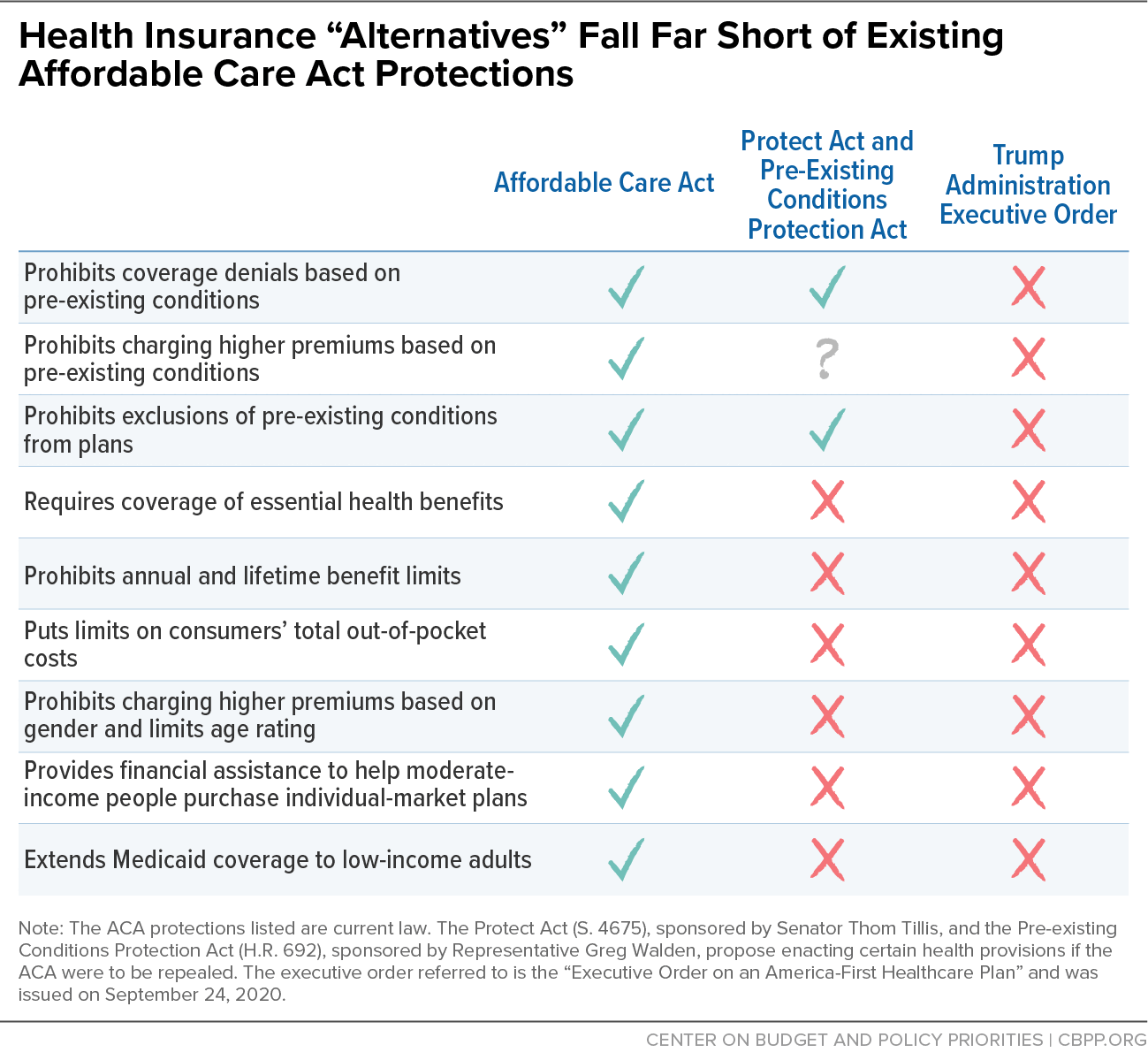Commentary: ACA “Alternatives” Don’t Protect People With Pre-Existing Conditions
End Notes
[1] Julie Appleby, “Cory Gardner’s Bill Has As Much to Do with Politics as Pre-Existing Conditions,” Kaiser Health News and PolitiFact HealthCheck, September 18, 2020, https://khn.org/news/cory-gardners-bill-has-as-much-to-do-with-politics-as-preexisting-conditions/.
[2] United States, Executive Office of the President [Donald Trump], “Executive Order on an America-First Healthcare Plan,” September 24, 2020, https://www.whitehouse.gov/presidential-actions/executive-order-america-first-healthcare-plan/.
[3] Susannah Luthi and Rachel Roubein, “Trump makes fresh health care push, saying he’ll protect sick Americans,” Politico, September 24, 2020, https://www.politico.com/news/2020/09/24/trump-health-executive-orders-billing-421383; and Caitlin Owens, “Trump’s latest empty health care rhetoric on pre-existing conditions,” Axios, September 25, 2020, https://www.axios.com/trump-pre-existing-conditions-executive-order-45e86c69-a620-42d4-a3d6-e952d9040e4d.html.
[4] The executive order states, “I have agreed with the States challenging the ACA, who have won in the Federal district court and court of appeals, that the ACA, as amended, exceeds the power of the Congress. The ACA was flawed from its inception and should be struck down.” For more, see “Suit Challenging ACA Legally Suspect But Threatens Loss of Coverage for Millions,” CBPP, updated August 21, 2020, https://www.cbpp.org/research/health/suit-challenging-aca-legally-suspect-but-threatens-loss-of-coverage-for-tens-of.
[5] Aviva Aron-Dine, “Trump’s Health Care Plan Would Do Much the Same Damage as His Effort to Repeal ACA Through the Courts,” CBPP, July 8, 2019, https://www.cbpp.org/blog/trumps-health-care-plan-would-do-much-the-same-damage-as-his-effort-to-repeal-the-aca-through; and “Trump Administration’s Repeal Suit Stance Is In Line With Its Health Care Agenda,” CBPP, updated February 21, 2020, https://www.cbpp.org/research/health/trump-administrations-aca-repeal-suit-stance-is-in-line-with-its-health-care-agenda.
[6] Protect Act, S. 4675, https://www.congress.gov/bill/116th-congress/senate-bill/4675/text.
[7] Pre-existing Conditions Protection Act of 2019, H.R.692, https://www.congress.gov/bill/116th-congress/house-bill/692/text.
[8] Katie Keith, “What It Means to Cover Preexisting Conditions,” Health Affairs, September 11, 2020, https://www.healthaffairs.org/do/10.1377/hblog20200910.609967/full/.
[9] Kaiser Family Foundation, “Analysis: Before ACA Benefits Rules, Care for Maternity, Mental Health, Substance Abuse Most Often Uncovered by Non-Group Health Plans,” June 14, 2017, https://www.kff.org/health-reform/press-release/analysis-before-aca-benefits-rules-care-for-maternity-mental-health-substance-abuse-most-often-uncovered-by-non-group-health-plans/.
[10] Ibid.
[11] Aviva Aron-Dine, “States Can’t Protect Themselves From Harmful Effects of ACA Repeal,” CBPP, January 10, 2020, https://www.cbpp.org/blog/states-cant-protect-themselves-from-harmful-effects-of-aca-repeal.
[12] Kaiser Family Foundation, “Potential Impact of California v. Texas Decision on Key Provisions of the Affordable Care Act,” September 22, 2020, https://www.kff.org/health-reform/issue-brief/potential-impact-of-california-v-texas-decision-on-key-provisions-of-the-affordable-care-act/#grouphealthplans.
[13] Thomas D. Musco and Benjamin D. Sommers, “Under the Affordable Care Act, 105 Million Americans No Longer Face Lifetime Limits On Health Benefits,” ASPE, March 2012, https://aspe.hhs.gov/basic-report/under-affordable-care-act-105-million-americans-no-longer-face-lifetime-limits-health-benefits; and Loren Adler and Paul Ginsburg, “Health Insurance as Assurance: the Importance of Keeping the ACA’s Limits on Enrollee Health Costs,” Brookings Institution, January 17, 2017, https://www.brookings.edu/blog/usc-brookings-schaeffer-on-health-policy/2017/01/17/health-insurance-as-assurance-the-importance-of-keeping-the-acas-limits-on-enrollee-health-costs/.
[14] Congressional Budget Office, “How Repealing Portions of the Affordable Care Act Would Affect Health Insurance Coverage and Premiums,” January 2017, https://www.cbo.gov/sites/default/files/115th-congress-2017-2018/reports/52371-coverageandpremiums.pdf.
[15] Price Waterhouse Coopers, LLC, “Challenges of partial reform – Lessons from State Efforts to Reform the Individual and Small Group Market Before the Affordable Care Act,” February 2017, https://www.chcf.org/wp-content/uploads/2017/12/PDF-ChallengesStateReformBeforeACA.pdf; Harris Meyer, “ACA repeal without replacement could spur insurer exodus,” Modern Healthcare, November 19, 2016, https://www.modernhealthcare.com/article/20161119/MAGAZINE/161119891/aca-repeal-without-replacement-could-spur-insurer-exodus; and Christopher Koller, “Why Republican health reform ideas are likely to fail,” Politico, December 7, 2016, https://www.politico.com/agenda/story/2016/12/republican-health-reform-ideas-obamacare-unlikely-work-000252/.
[16] Jesse Cross-Call, “Michigan Medicaid Proposal Would Lead to Large Coverage Losses, Harm Low-Income Workers,” CBPP, April 19, 2018, https://www.cbpp.org/research/health/michigan-medicaid-proposal-would-lead-to-large-coverage-losses-harm-low-income.
[17] Benjamin D. Sommers et al., “Three-Year Impacts Of The Affordable Care Act: Improved Medical Care And Health Among Low-Income Adults,” Health Affairs, Vol. 36, No. 6, June 2017, https://www.healthaffairs.org/doi/full/10.1377/hlthaff.2017.0293.
[18] Ausmita Ghosh, Kosali Simon, and Benjamin D. Sommers, “The Effect of Health Insurance on Prescription Drug Use Among Low-Income Adults: Evidence from Recent Medicaid Expansions,” Journal of Health Economics, Vol. 63, November 6, 2018, https://www.sciencedirect.com/science/article/abs/pii/S0167629617300206.
[19] Sarah Miller, Norman Johnson, and Laura R. Wherry, “Medicaid and Mortality: New Evidence from Linked Survey and Administrative Data,” National Bureau of Economic Research Working Paper No. 26081, updated August 2020, https://www.nber.org/papers/w26081?sy=081.
[20] Jacob Leibenluft, “CBO Analysis Refutes Ryan Claims that House Health Bill Maintains Protections for Pre-Existing Conditions,” CBPP, May 26, 2017, https://www.cbpp.org/research/health/cbo-analysis-refutes-ryan-claims-that-house-health-bill-maintains-protections-for.
[21] Aviva Aron-Dine, “Cassidy-Graham’s Waiver Authority Would Gut Protections for People with Pre-Existing Conditions,” CBPP, September 15, 2017, https://www.cbpp.org/blog/cassidy-grahams-waiver-authority-would-gut-protections-for-people-with-pre-existing-conditions.
[22] Edwin Park, “New CBO Estimate: Still 22 Million More Uninsured Under Revised Senate Republican Health Bill,” CBPP, July 20, 2017, https://www.cbpp.org/research/health/new-cbo-estimate-still-22-million-more-uninsured-under-revised-senate-republican.
[23] Tara Straw and Aviva Aron-Dine, “ACA Repeal Even More Dangerous During Pandemic and Economic Crisis,” CBPP, October 5, 2020, https://www.cbpp.org/health/commentary-aca-repeal-even-more-dangerous-during-pandemic-and-economic-crisis.

